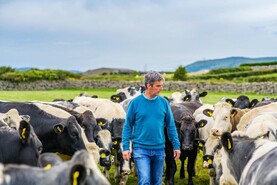AgriSearch held a farm walk on red clover silage production on the farm of Francis McDonnell, Dromore, Co Tyrone, on Thursday 12 June.
The farm extends to 110 acres (24.7 hectares), with 50 dairy cows which are milked using a Lely robot. The aim is to graze cows for 12 hours per day during the summer months.
Francis is a relatively new entrant to dairying, having started milking in 2018. Cows are currently achieving an average yield of 28.8kg milk per day at 4.41% butterfat, 3.39% protein. Cows are milked on average 2.8 times per day with a predicted herd annual milk yield of 7,800l per cow.
Third rotation
Cows are currently into the third grazing rotation and have access to the grazing platform from 3am onwards after first milking.
“The layout of the cow house is set up in a way that cows have to be milked to get out to graze and milked again before they can come back to gain access to silage,” Francis said.
The future focus on the farm is moving towards breeding replacement heifers within the herd using sexed semen, with replacements previously being sourced from one dairy farm.
The aim of the ZeroNsile project is to produce high-quality red clover silage without the use of manufactured nitrogen (N) fertiliser. Francis established the red clover sward on his enterprise in spring 2024.
A grass clover seed mix has been selected to suit the heavy clay, running to peat moss soil type of the farm.
The mix contained a high proportion of Timothy and late varieties of perennial ryegrass alongside 1kg white clover and 3.5kg red clover.
Soil pH is key to clover establishment and should be around 6.5 before sowing commences.
The old sward and weeds (mainly docks) were sprayed off and the field was disced in order to achieve a firm seed bed. Sowing was completed using an airseeder and the area rolled prior to and after sowing in order to aid establishment of seed.
In 2025, the red clover sward was cut when 50% clover flowers were present in early May and harvested 24 hours later yielding 6.5bales/acre, which is equivalent to 3.5t/ha.
Take home messages of growing red clover
Francis informed the group that red clover is slow to get growing in cold, wet conditions in comparison to grass.
He also found it challenging to get the nutrient balance correct with slurry alone. There is a need to be well organised in advance by ordering phosphorus and potassium only fertilisers as they are difficult to access.
The red clover needs to flower once a year and it’s important to not cut it too low otherwise the plant dies.
Reason
Francis highlighted that you also need to have a reason to grow the red clover silage on farm and have a requirement for a high-protein feed.
In general, the experience across the project is that red clover silage tends to feed better than it tests, added John Morrow from AgriSearch.
During his presentation, David Linton from Barenburg highlighted that leaf breakage in red clover can be a problem when tedding.
Once it starts to dry out the leaf is very brittle and care needs to be taken not to lose significant amounts of leafage as this is where the protein is located, he said.






 This is a subscriber-only article
This is a subscriber-only article











SHARING OPTIONS: